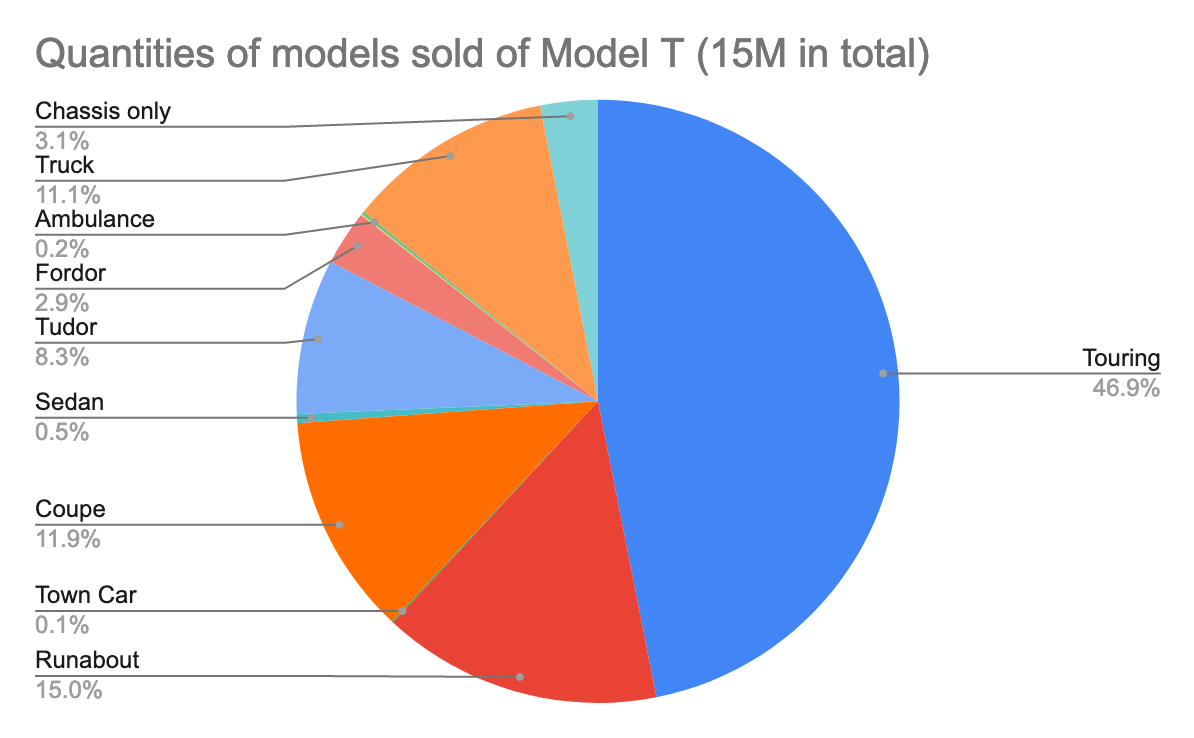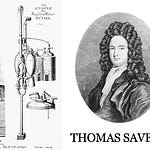✅ Podcast version also available on Spotify, Apple Podcasts and Google Podcasts.
I believe that in every startup or innovative company the quote “Any colour as long as it’s black” has been dropped at least once.
Henry Ford’s famous quote is often used as an argument for reducing options in a product. Many people believe that Henry Ford was all about limiting choice.
Actually, there’s quite some nuance to that. This is the untold story of ‘any colour as long as it’s black’. When I say untold, I mean not often heard, as Henry Ford wrote a fascinating autobiography covering the matter.
Let’s go back to the start of the previous century.
Nine times a charm
In 1903, 39-year-old Henry Ford started the Ford Motor Company. During the first years, it produced a couple of cars a day. By 1908, The Ford Motor Company introduced 8 different models with varying results.

In 1908, Ford launched their latest: The famous Model T. It was an instant hit. In the first year, they sold more than 10.000 cars, outselling any competitor of that year. Ford was the first company to cross the 10k mark, as a company and for a single car. Unprecedented.
After that successful first year, The Ford Motor Company was ready to grow. The sales staff was amazed by the great sales numbers. They were so excited, they suggested adding an extra car to the line-up with some changes.
Change a winning formula?
Sales heard requests from certain customers about the style of the car. If implemented in a new model, they could make more sales. Ford felt that the suggestion from sales was weird. The Model T, nicknamed Tin Lizzie, was the most popular car ever.
“It is strange how, just as soon as an article becomes successful, somebody starts to think that it would be more succesful if only it were different. There is a tendency to keep monkeying with styles and to spoil a good thing by changing it.”
The car-trepreneur (sorry for that) was wondering why you would add another car to that. It's not that Ford didn't value customer feedback. You can clearly see that in his auto-biography (get it? because cars):
"No business can improve unless it pays the closest possible attention to complaints and suggestions. If there is any defect in service, then that must be instantly and rigorously investigated"
Aim for 95% of the market
The entrepreneur in him didn’t see the opportunity as the salesmen saw it. Ford had a particular philosophy on the mass market which he makes explicit in his biography.
He describes three groups within a market: 1) people that don’t know what they want, 2) people that claim they know what they want and 3) people that actually know what they want.
“If you discover what will give this 95% of people the best all-round service, [..], you will be meeting a demand which is so large that it may be called universal”
‘Universal demand’ sounds a lot like product-market fit. According to Ford, the sales staff voiced the concerns of that very special 5%. He saw the other 95% per cent as the real market for any product.
Not all feedback comes equal
He interpreted those superb sales as serving those 95% of customers. Today we would say that he had product-market fit.
Next to that, he looked into the nature of the feedback from the salesmen. Salesmen wanted to add a car with a different style. Ford hated that:
“when the [customer] suggestion is only as to style, one has to make sure whether it is not merely a personal whim that is being voiced.”
For Ford, personal whims were unimportant impulses of the customer that wouldn’t bring value. He writes about his frustration that salesmen wanted to fix these whims because the salesmen want to close these extra sales and get the extra commission.
Our man Henry understood that you can’t say yes to every request: He was aware of ‘feature creep’ avant la lettre. A couple of weeks later, the visionary businessman laid out his plan for the company. But, in a different direction than the salesmen asked for.
I see a red car and I want it painted black
Contrary to popular belief, the Model T was initially available in the colours blue, grey, green, and red. Not in black. Salesmen wanted to add styles.
In 1909, out of the blue, Henry announced his well-known policy to his staff:
‘Any customer can have a car painted any colour that he wants so long as it is black’
Remember, the first iPhone also only came in one colour. How big of an issue was that, really? What about that extra model the salesmen wanted? Ford added to his policy:
“[..]in the future we were going to build only one model: the Model T”
This means that the Model R and the Model S that were being sold were killed. Those two cars were good for more than 5000 sales in the past years. How many startups do you know that limit their product line and kill products with traction?
Instead of adding a model, Ford removed 2 models. How contrarian to the suggestion of the sales staff. Pieter Thiel would be proud. It was not well received by the salespeople:
“I cannot say that any one agreed with me. The selling people could not of course see the advantages that a single model would bring about in production. More than that, they did not particularly care.”
Only black didn’t mean no options
The fun thing is, he actually announced it in reverse order. He first said: ‘Only Model T’, and ended with ‘only black’. For some reason, everyone only remembers the latter.
While the former is where the nuance lies: it was not as black and white as it seems. It didn't mean that there was only one Model T, like with there only being one iPhone at launch.
The full sentence uttered by Ford was:
“in the future we were going to build only one model, the Model T and that the chassis would be exactly the same for all cars”
Meaning, the Model T was what historians call the first platform car. There were many variations of the Model T, all build on the same basis.
He experimented with repurposing the chassis of de Model C for the Model E. He knew what he was attempting already worked.
Initially, there were six variants available.
Over the years, other variants were added.
So, there was plenty of choice. This is a very important, often missed insight from this story. Ford clearly acknowledged the different needs of different customer segments, reflected in the high variety of models displayed above.
He just didn’t think colour would be important to conquer this market.
Many benefits of a platform car
There were definite benefits to having a platform car. He could swap parts from the different Model T variants. For instance, the town Car headlights could fit on the Model T Truck.
This also made repairs easier and overall reduced production times & costs. Inventory costs were also cut down, as you don’t need to keep 4 colours of each door. Ford’s pricing & cost reduction strategy is truly amazing, this deserves an article in itself, but the pricing strategy hugely influenced the sales as well.
Liftoff!
Ford spoke the ‘all colours but black’-words in the 2nd year of the Model T Ford's lifetime. It took a couple of years to change the factories before production really ramped up.
For 9 years, between 1914 and 1925, Ford sold only black cars, only model Ts. In total, Ford sold 15 million Model Ts. This was the best-selling car ever. The record stood for almost half a century until Volkswagen ultimately sold its 15.007.034th Beetle in 1972.
For some years, he sold a million cars, where the best competitor, Chevrelot did about 300.000. For comparison, in 2021, Lexus sold 760.000 cars, and Tesla 900.000.
More than half were ‘non-default’
The Model T Touring (below) was the most popular variant. That car amounted to about half of the sales of the Model T, the truck and the coupe were particular popular.
The vast majority of Model Ts were black
Ford sold colours in the first years and started ‘Only Black’-1914. Only when sales started dipping in 1925, did they add colours again. Two years later after adding colours, in 1927, the Model T was discontinued. 85% of all Model T cars ever sold were black.

Ford does it, again
To summarise, “any colour as long as it’s black” was about reducing choice on one aspect: colour. But, the Model T Ford had a high variety of options.
It’s a story of knowing where to limit choice for your customers and where not. It’s about understanding what it takes to conquer a mass consumer market.
Ford reverted his decision of colours in 1925. Today, Ford makes cars in many colours for many different models. However, in 2018, Ford decided only make to SUVs and trucks and stop producing all other cars, like the Ford Focus. Sounds familiar, right?
How was this one?
Great - Good - Meh
Voting is anonymous and voters live longer
Need 1 on 1 help?
I help founders build products people want. Get to your first customer, or grow your current base. Can you use some help? Send me an email at ik@jeroencoelen.nl or read some testimonials here.




















Share this post